Creative school plans could counter inequities exposed by COVID-19
Solutions include boosting tech access, tutoring and in-person school for the youngest kids
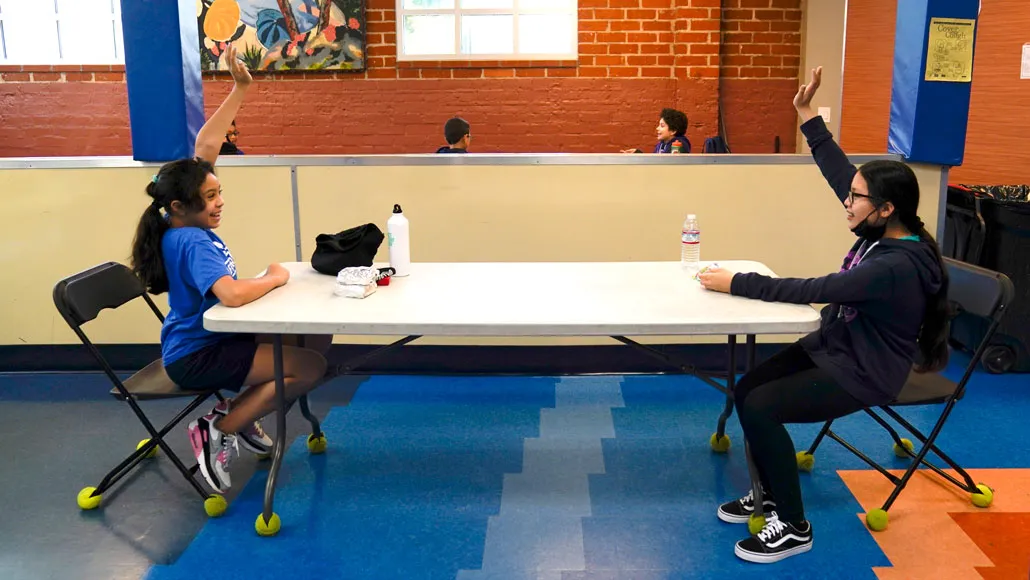
Due to COVID-19, many schools across the United States are continuing remote online teaching this fall, which threatens to widen preexisting achievement gaps. Organizations like the Boys & Girls Club of Hollywood in Los Angeles, shown, are providing eligible students with free food, shelter and help with remote learning.
Jae C. Hong/AP Photo
The emergency pivot to remote learning for K–12 students last spring illuminated longstanding educational fault lines in the United States. The most vulnerable students — children with disabilities, English language learners and children from marginalized Black, Hispanic and Native American communities — were less likely than their affluent and mostly white peers to have basic necessities such as regular meals, a quiet place to work, computer access, guidance on how to get online and even online access itself.
Even before the COVID-19 pandemic, education researchers were sounding the alarm that the country’s achievement gap between students from low- and high-income households had remained unchanged for almost half a century, with the poorest students performing at academic levels three to four years below that of the wealthiest students (SN: 3/19/19).
Spring’s events may have pushed disadvantaged students even further behind. In a May working paper, researchers at Brown University in Providence, R.I., used typical rates of learning loss that occur over summer vacation to estimate learning losses incurred by spring school closures. Their calculations suggest that students, on average, will return to school this fall having retained only about a third to half of the math skills acquired during a normal school year, and 63 to 68 percent of their reading skills. But those learning losses are uneven, with readers in the top third proficiency level potentially even accelerating their rate of learning during school closures.
This fall, with COVID-19 still surging throughout the country, many schools are reopening either entirely online, or with an online–in person hybrid schedule. Assuming full in-person instruction does not resume until January 2021, global consulting firm McKinsey & Company estimates that the students may fall behind nearly seven months on average. For white students, the average is six months. In comparison, Hispanic students would be set back more than nine months, Black students more than 10 months, and low-income students, over a year. Overall, existing racial and socioeconomic achievement gaps could expand by 15 to 20 percent, the group estimates. Education researchers fear that students who suffered the greatest learning losses in the spring may never catch up.
Widening the gap
Research shows that virtual learning in K–12 schools this fall could widen preexisting achievement gaps in education. The global consulting company McKinsey & Company estimates that if schools continue remote online learning until January 2021, Black, Hispanic and poor students will be set back at least nine months of education on average compared with average losses of six months for white students.
Average lost learning time, in months, if in-school return is delayed to January 2021, by race and economic status
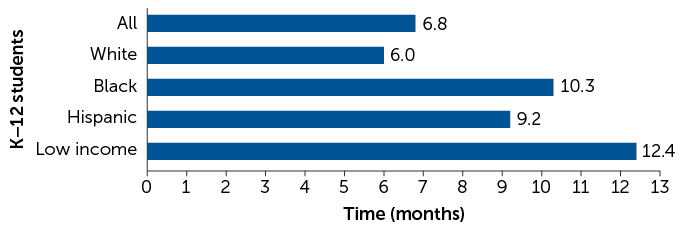
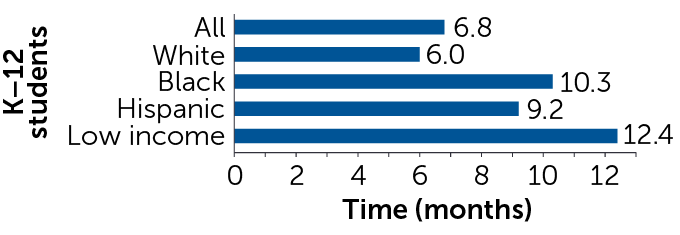
“There were gaps before. Now they’re wider,” says education economist Douglas Harris of Tulane University in New Orleans. “A great accomplishment, unfortunately, would be to get back to where they were before this pandemic started.”
In an open letter that has now garnered around 500 signatures from education experts around the country, Harris and Katharine Strunk of Michigan State University in East Lansing outlined seven focus areas for helping the country’s most vulnerable students. A version of the letter appeared in Education Week. Topping the list were state- and federal-level asks: A massive infusion of funds to stave off looming school budget cuts and provision of computer and internet access for all students. The other items focus on what schools can do with those resources.
Sign up for our newsletter
We summarize the week's scientific breakthroughs every Thursday.
But with large-scale government assistance unlikely, school districts have to figure out what they can do on shoestring budgets, using best available evidence. Solutions include boosting technology access for students, leveraging low-tech, community-based efforts, tutoring and special provisions for the youngest learners.
Bridging the digital divide
Best estimates suggest that 10 to 20 percent of students lacked access to devices such as tablets or computers, the internet or both, during the spring shift to online instruction. Hispanic, Black, low-income and rural students were most likely to lack access. An April survey from the Washington, D.C.–based Pew Research Center found that some 43 percent of low-income students would likely have to complete their homework on a cell phone.
Some school districts quickly mobilized to bridge that digital divide. In Guilford County, N.C., where over 66 percent of the district’s 71,000-plus students live in poverty, two local nonprofits joined forces to purchase laptops for thousands of students. Additionally, the district used money from the CARES Act, a federal coronavirus relief fund, to buy almost 80,000 devices for students, staff and teachers for fall. But back orders nationwide mean half the items might arrive late, a school spokesperson says.
In May, and again this fall, the district rolled out “smart” buses with Wi-Fi hot spots in areas without reliable internet access. Each of the 125 buses can support 65 simultaneous connections, with the signal extending over 90 meters. The $1,000 apiece price tag to outfit the buses was covered by a grant from Chiefs for Change, a bipartisan group of school leaders headquartered in Washington, D.C.
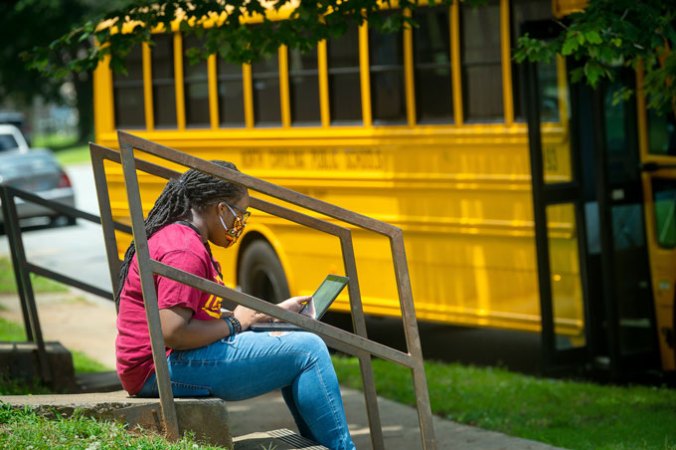
Other districts have received support from state and local governments. City leaders joined Chicago Public Schools and philanthropic groups in creating Chicago Connected, a $50 million initiative to provide 100,000 students with free high-speed internet for four years. Over 18,000 students had signed up before fall classes started.
Beyond internet access, just taking steps to make sure students show up online has helped ensure access. Leaders in Florida’s Miami-Dade County Public Schools experienced with unpredictable school closures thanks to hurricanes, went door-to-door with the help of local police and community partners to check on absent students and provide them with devices and hot spots.
Guilford and Miami-Dade reported that in some weeks, over 90 percent of students logged on to classes, though average attendance trended lower. Even the basic act of taking attendance sets those districts apart, says Bree Dusseault, an education researcher at the Seattle-based Center for Reinventing Public Education, a nonpartisan public school reform research group affiliated with the University of Washington Bothell. Among the more than 100 schools — serving almost 10 million students — in the center’s database, only a third of districts tracked attendance.
What works in urban and suburban districts doesn’t always translate well to rural areas without high-speed internet infrastructure, according to a report from the Brookings Institution in Washington, D.C. In those cases, lower-tech workarounds can help students keep up. One Ohio district uploaded videos onto USB drives and hand-delivered them to students. Elsewhere, teachers called students on the phone to check on their progress.
Pandemic pods, community education and tutoring
Some parents have banded together in so-called pandemic pods to teach their kids, sometimes with the help of a paid tutor or teacher. This model has attracted media attention in part because of its potential to worsen inequities, since not everyone can afford to hire an educator.
But single mom Yenda Prado has a positive outlook on pods, which she first experienced during summer visits to her grandmother’s village in Mexico. There, community pods formed for exchanging services such as English lessons and housekeeping.
“When families and communities are in crisis, that’s when they come together to pool and share resources,” says Prado, a fifth-year doctoral student in education at the University of California, Irvine.
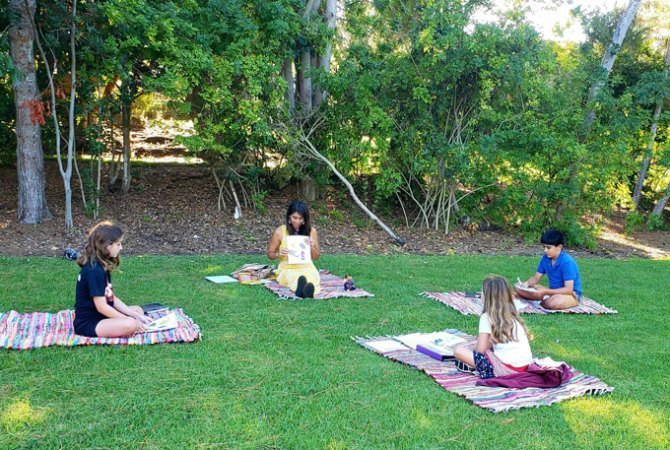
She created a pilot pod with her 9-year-old son and some classmates in June, and is assessing how to scale up that setup through her affiliation with the Orange County Educational Advancement Network, or OCEAN. The consortium encompasses some area K–12 schools, various nonprofits and UC Irvine. Prado’s goal is to connect small groups of students at OCEAN’s affiliate schools with undergraduate “fellows.” Those fellows will receive service or field study credit for their work, or simply volunteer. Fellows can provide academic support, but their main role is facilitating member bonding and community building. “That is what’s missing from the educational landscape right now,” Prado says.
Such strengthening of ties between community organizations and schools could present a chance for educators to make learning resonate with students of all backgrounds. Research shows, for instance, that when curriculum is made ethnically relevant for students, dropout rates go down and grades and attendance go up. Even when such programs exist outside of school, such as through community-run after-school programs, they can help students integrate what they’re learning at school with their lived experiences.
“This moment … as sad as it is, I think it’s a great opportunity for education to not only be reclaimed by communities, but for schools to recognize that they’re not the only places of learning and development, and they have to be able to do this together,” says community-based education researcher Bianca Baldridge of the University of Wisconsin–Madison.
Community and faith-based organizations and local funders in Indianapolis rose to the occasion by creating a learning hub that gives priority to students who struggled with low attendance in the spring, and those experiencing homelessness. And San Francisco’s Parks and Recreation Department is partnering with area nonprofits to provide 6,000 childcare spots for children in grades K–6, with priority given to students in greatest need.
Elsewhere, districts are pursuing tutoring models to provide personalized in-person or remote academic support. Just over a tenth of districts in the Center for Reinventing Public Education’s database are looking into such plans, Dusseault says. The Los Angeles Unified School District, which is all-online this fall, is providing 500 K–8 students with free tutors, who are volunteers with a group called Step Up Tutoring.
Matching struggling students with tutors 1-to-1 or 2-to-1 is a surefire way to help close opportunity gaps, says Matthew Kraft, a Brown University education economics researcher. Tutoring works best during the school day, he has found. A July working paper out of the National Bureau of Economic Research reported substantial learning gains among participants in 96 programs lasting 10 weeks to a year, with mostly low, often 1-to-1, student-tutor ratios. A nationwide tutoring corps could be rolled out by expanding Americorps, a federally funded national service program, Kraft and others suggest.
Prioritizing in-person learning for younger children
For the youngest students, in-person instruction makes sense from both public health and education standpoints.
For reasons that are not entirely clear, younger children appear less likely than older children and adults to transmit the virus that causes COVID-19 (SN: 8/4/20).
In a July policy brief, education researchers Kathleen Lynch of Brown University and Heather Hill of Harvard University point to multiple lines of evidence supporting in-person instruction for younger students. Learning growth rates are substantially higher in grades K–2 than in later grades, and failure to understand the building blocks of numeracy and literacy in those early years can lead to academic difficulties later.
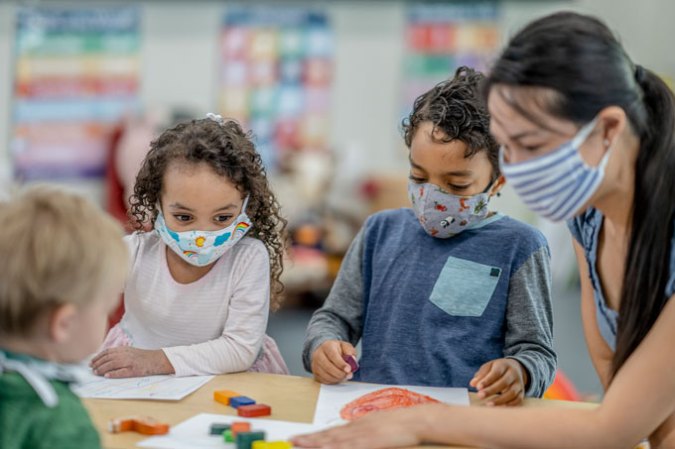
In addition, very young students do not generally possess the attention and self-regulation skills needed for all-online instruction. Even when those students have computers and internet access, online classes remain a challenge, says Chris Curran, an education policy expert at the University of Florida in Gainesville. Young children can’t reasonably be expected to pay attention to online classes for hours on end, or complete simple tasks, such as writing their name on a piece of paper, without adult assistance.
Some school districts are trying to bring younger kids into physical classrooms before older kids. For instance, Kansas City Public Schools will start entirely online September 8, but if the city sees a 14-day decline in COVID-19 cases and city health officials OK school reopening, youngsters in grades K–3 can return in person full-time. After another 14-day decline, students in grades 4 to 8 can return part-time.
When opening in person is just not an option, Curran says districts must adapt to younger students’ needs, such as by handing out art project materials. “Technology can’t be the only solution, particularly for really young students,” he says.

Trustworthy journalism comes at a price.
Scientists and journalists share a core belief in questioning, observing and verifying to reach the truth. Science News reports on crucial research and discovery across science disciplines. We need your financial support to make it happen – every contribution makes a difference.







